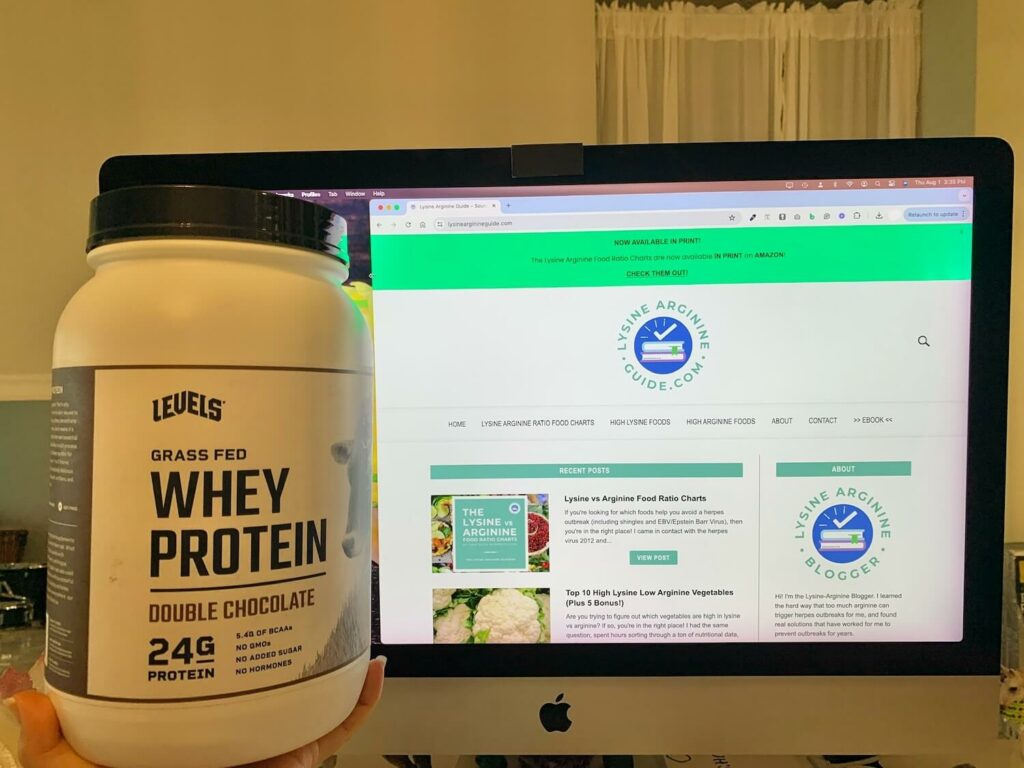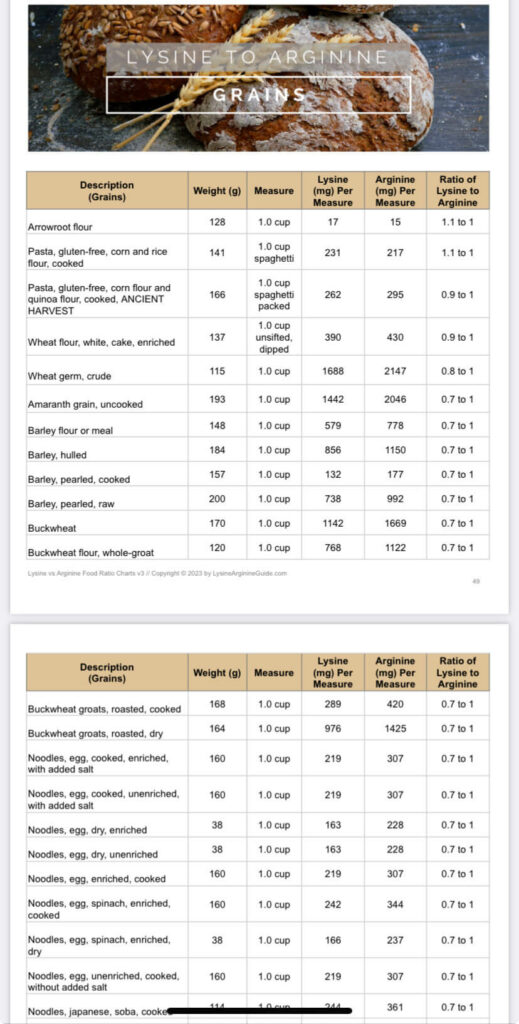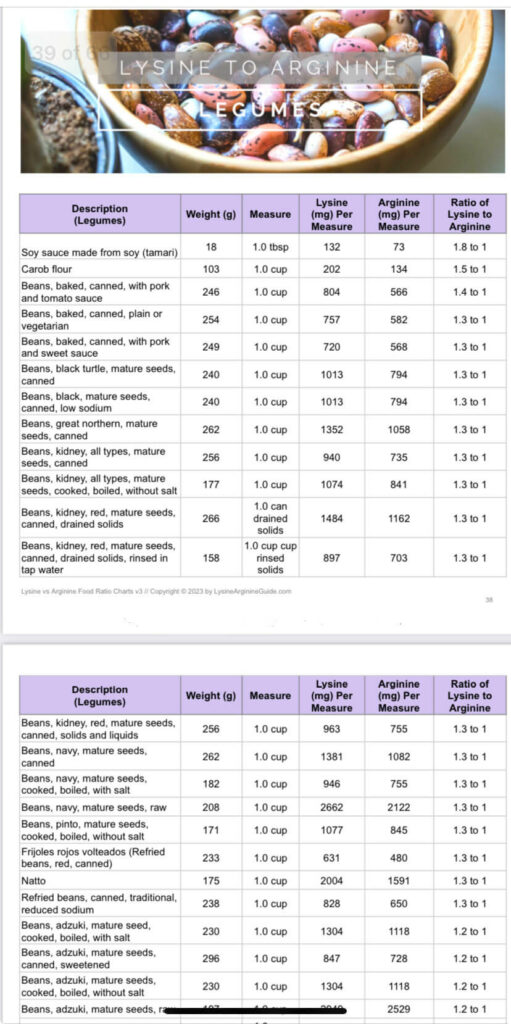Hey there!
Welcome to the FAQ page. 🙂 Below you will find the most common questions I receive and my response for each. (This page is currently being improved, so please bear with me!)
I’m sure you know (but I have to mention!) that I’m not a licensed health practitioner so legally I can’t provide specific advice to anyone regarding supplements, medicine, dietary changes, etc. Working with a trusted, qualified health professional is the best way to get personalized guidance according to your unique health history and current state of health.
That being said, what I share in my answers below is based on what I’ve personally experienced and what I’ve heard from some of my readers. My hope is that the answers I share give you some information to consider, then you can make a decision according to what you feel is best for you. 🙂
Wishing you vibrant health always!
The Lysine-Arginine Blogger
Can I take a lysine supplement to offset a high arginine food/meal?
ANSWER: Hi! Both myself and my readers have successfully supplemented with lysine to offset ratios on occasion. I have personally used these lysine tablets a few times in the beginning of my journey, but I only tried it with meals that were mildly high in arginine, and I intentionally calculated the ratio in advance. It probably wasn’t exact, but I estimated as best as I could and I was fine. I personally didn’t experience any OBs when I did that, but I can’t guarantee that everyone else will have the same experience. (Note: I didn’t take the lysine and then proceed to eat a jar of peanut butter – although I would have liked to! haha).
If you want to try offsetting arginine in a meal by taking lysine, here are some things I’ve learned that you might want to keep in mind:
- Everyone’s body is different and tends to react more or less sensitively to food and even supplements.
- The more you work with your body and notice how it responds to what you put in it, the better and better you will get at predicting how it will respond.
For example, my digestive system absolutely does not agree with lysine powder. However, some people are able to take it without experiencing the same – ahem – side effects that I did. When I switched to lysine tablets, I was fine.) - Make sure your body is okay with the lysine supplement beforehand.
(You don’t want to be away from home and discover your belly is NOT happy with the supplement. Ask me how I know! Lol) - Do your best to calculate the lysine vs arginine ratio ahead of time.
This is so you can know how much of the high arginine food you feel safe eating as well as how much lysine you feel comfortable supplementing with to offset it, based on the research you do. (*Within reasonable and known daily intake amounts for most people. I don’t think someone should eat an extremely high arginine meal and then take an unsafe amount of lysine to offset it.) - Based on my research, no one really knows the long-term effects of supplementing with lysine, and there is no set standardized dose, so keep that in mind when making your decisions.
(Another good reason to work with a professional.) Also, as with any supplements, the levels of quality will vary, so make sure you are purchasing from a reputable company that you trust.
Do you genuinely use the protein powder you promote?
Reader: I have had issues with protein powder causing cold sore flare ups in the past. I realize that you are an Amazon affiliate but I wanted to ask if you genuinely have used the product you suggested without issue? I would like to try it but I wanted to double check before and make sure this was not just an advertising gimmick.
Answer: Hey there! Yes, If you’re talking about Levels Protein Powder, that’s the one I’ve been buying for a while now and the one I recommend.
Also, they have smaller sizes available if you want to spend less up front until you try it out. (1lb or 2lb options depending on the flavor.) It works out to be a little more per ounce, but it would be less of a risk if you decide you don’t like the flavor.
I took a quick pic of me holding my container with the blog in the background so you can see I really buy and use it.

Protein shakes are okay as long as they have more lysine than arginine, right?
Reader: I drink protein shakes but not all of them have the lysine/arginine ratio listed on the label. The ones that do, as long as lysine is higher, I’m ok, right?
Answer: Hi! Based on what you shared, the first thing I would look at are the ingredients in the protein shakes you mentioned. Even if they don’t have a lysine/arginine ratio listed, you can get a sense for what the ratio might be based on that. For example, some companies are starting to add other protein sources along with whey protein (to create a “protein blend”), which can be very high in arginine and low in lysine. Pea protein, rice protein, and any nut or seed-based protein are red flags that the product could very likely contain more arginine than lysine. Also, look out for other things that might be added to the formula, such as collagen or bone broth and definitely look out for these in other vitamins/supplements as well.
Does coffee cause OB’s?
Reader: I’m a highly sensitive person and wondering if coffee might be irritating my nervous system. Do you have any insights into coffee as a trigger? A week ago I stopped coffee and went back to black tea, but I do miss my morning brew!!
Answer: Yes, unfortunately, coffee can be a trigger. I haven’t written about it on the blog yet, but soon I’m going to be sharing about how Nervous System Regulation can help to prevent outbreaks. I started practicing it for other reasons about a year and a half ago and noticed this post from my teacher. I wanted to share this with you because you’re already tapped into the connection with the nervous system!
Based on what I’ve researched and personally experienced so far, I truly believe that regulating the nervous system is a foundational key to healing on all levels. Mainstream medicine has not caught on to this yet, but I believe it will revolutionize healthcare in the future. 🙂
By the way, the term “regulating the nervous system” is a very simple term for a huge topic, so I’ll just leave it at that for now so this email doesn’t turn into a book!
Thanks so much for the encouraging words, they mean a lot! Let me know if you have any other questions or if there’s anything else I can help you with.
🌟NEW!🌟 Reader Feedback: Thank you so much for your tremendous research!!
Regarding the FAQ where a reader asked about coffee, my husband and I are enjoying decaf, the Costco Kirkland dark roast decaf which is Swiss water decaffeinated instead of chemically.
It is delicious.
We brew it in a simple Italian moka pot espresso style so it is very strong.
I take only two ounces of coffee, add to it 8 ounces of milk, sorta like a latte, and recommend it as heavenly.
If your reader however is missing the buzz and jolt of real coffee, well, this won’t help.
But the flavor? Amazing. I will leave it to you to determine decaf’s impact on the nervous system. It will be a drag to learn if decaf coffee is still an adverse impact on the nervous system. The struggle is real. Lol.
Thank you so much for all you do!!!
P.S. Peet’s Coffee Major Dickason’s Blend decaf is also a dark roast and delicious but more pricey. For people who like medium or light roast, there are probably those decafs out there, too. Also, people can make those coffees in any type of coffee makers – Peet’s even has decaf Kcups – and folks can drink it black if they prefer.
Answer: “Thank you so much for your kind words. And what a great tip, thank you for sharing it with me. It sounds delicious!! Based on my research, I haven’t come across anything specific to coffee other than the caffeine content, so that is a great option!”
The reader then gave me permission to share this awesome tip here with all of you. So enjoy that yummy decaf recipe and extra special thanks to my dear reader! 🙂
Do your Lysine Arginine Food Ratio Charts contain all types of foods?
Reader: I’m interested in purchasing your Lysine/Arginine food ratio charts. However, I want to know first if it has all the types of foods (or food groups, if you will). I’ve found some that are only for vegans/vegetarians, but I need more comprehensive info. Does it contain meat (like beef, chicken, pork, seafood), grains, (like oatmeal, rice, quinoa, popcorn), veggies/fruit, nuts/seeds, healthy fats (like coconut oil, avocado oil, tallow, olives), and dairy?
Answer: Yes! The charts are separated into 7 categories/food groups, which are:
1. Meat + Seafood
2. Dairy + Eggs
3. Fruits
4. Veggies
5. Legumes
6. Grains
7. Nuts + Seeds
The USDA FoodData Central did not provide amino acid profiles for Fats/Oils, so it does not include a separate section for that. I have found conflicting information regarding oils; most information I came across stated that chemically, oils do not contain amino acids or protein, as well as other sources that promote the topical application of virgin coconut oil on active outbreaks due to its antiviral properties (from monolaurin). However, there are a couple sources that claim oils like coconut oil should be avoided because of the high content in coconut meat, although there was no scientific evidence cited to support that claim.
Regarding the specific foods you mentioned, yes to all of the meats, yes to all of the grains, although it lists oats but not specifically oatmeal, and corn but not specifically popcorn. I hope that makes sense! Let me know if you have any more questions. 🙂
Do your charts list legumes and grains individually?
Reader: Does your Lysine Arginine Food Ratio Charts list most legumes individually (ex, chickpeas, black beans, kidney beans, etc) and grains (wheat, whole wheat, white rice, brown rice, wheat berries, pasta, etc) or is it more generic?
Answer: Hi! Each food item is listed individually. 🙂 I’m on my phone right now but I took screenshots of the first page of the Legumes and the first page of the Grains and attached them here so you can see what it looks like. Let me know if you have any other questions or if there’s anything else I can help you with!


That’s it for now!
If you have a question that’s not listed here, please send it to me at thenameofthiswebsite at gmail dot com. 🙂
DISCLAIMER: THIS WEBSITE DOES NOT PROVIDE MEDICAL ADVICE.
Everything on this website, including but not limited to, text, graphics, images, and other material are for informational purposes only. Nothing on this website is intended to be a substitute for professional medical advice, diagnosis, or treatment. You should always seek the advice of your doctor or other qualified healthcare provider with any questions you may have regarding a medical condition or treatment and before trying a new health care regimen, including dietary and nutritional changes. Never disregard professional medical advice or delay in seeking medical care because of something you have read on this website.
Thank you and I’m wishing you vibrant, radiant health in all areas of your life!
